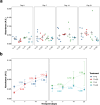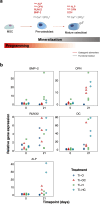Engineering a Hybrid Ti6Al4V-Based System for Responsive and Consistent Osteogenesis
- PMID: 38434873
- PMCID: PMC10905591
- DOI: 10.1021/acsomega.3c07232
Engineering a Hybrid Ti6Al4V-Based System for Responsive and Consistent Osteogenesis
Abstract
As the aging population increases worldwide, the incidence of musculoskeletal diseases and the need for orthopedic implants also arise. One of the most desirable goals in orthopedic reconstructive therapies is de novo bone formation. Yet, reproducible, long-lasting, and cost-effective strategies for implants that strongly induce osteogenesis are still in need. Nanoengineered titanium substrates (and their alloys) are among the most used materials in orthopedic implants. Although having high biocompatibility, titanium alloys hold a low bioactivity profile. The osteogenic capacity and osseointegration of Ti-based implantable systems are limited, as they critically depend on the body-substrate interactions defined by blood proteins adsorbed into implant surfaces that ultimately lead to the recruitment, proliferation, and differentiation of mesenchymal stem cells (MSCs) to comply bone formation and regeneration. In this work, a hybrid Ti6Al4V system combining micro- and nanoscale modifications induced by hydrothermal treatment followed by functionalization with a bioactive compound (fibronectin derived from human plasma) is proposed, aiming for bioactivity improvement. An evaluation of the biological activity and cellular responses in vitro with respect to bone regeneration indicated that the integration of morphological and chemical modifications into Ti6Al4V surfaces induces the osteogenic differentiation of MSCs to improve bone regeneration by an enhancement of mineral matrix formation that accelerates the osseointegration process. Overall, this hybrid system has numerous competitive advantages over more complex treatments, including reproducibility, low production cost, and potential for improved long-term maintenance of the implant.
© 2024 The Authors. Published by American Chemical Society.
Conflict of interest statement
The authors declare no competing financial interest.
Figures





Similar articles
-
Peptide LL-37 coating on micro-structured titanium implants to facilitate bone formation in vivo via mesenchymal stem cell recruitment.Acta Biomater. 2018 Oct 15;80:412-424. doi: 10.1016/j.actbio.2018.09.036. Epub 2018 Sep 25. Acta Biomater. 2018. PMID: 30266635
-
Improved osseointegration of 3D printed Ti-6Al-4V implant with a hierarchical micro/nano surface topography: An in vitro and in vivo study.Mater Sci Eng C Mater Biol Appl. 2021 Jan;118:111505. doi: 10.1016/j.msec.2020.111505. Epub 2020 Sep 11. Mater Sci Eng C Mater Biol Appl. 2021. PMID: 33255064
-
Bone marrow stromal cells generate an osteoinductive microenvironment when cultured on titanium-aluminum-vanadium substrates with biomimetic multiscale surface roughness.Biomed Mater. 2023 Mar 8;18(3):035001. doi: 10.1088/1748-605X/acbf15. Biomed Mater. 2023. PMID: 36827708 Free PMC article.
-
Nano-scale modification of titanium implant surfaces to enhance osseointegration.Acta Biomater. 2019 Aug;94:112-131. doi: 10.1016/j.actbio.2019.05.045. Epub 2019 May 22. Acta Biomater. 2019. PMID: 31128320 Review.
-
A critical review of multifunctional titanium surfaces: New frontiers for improving osseointegration and host response, avoiding bacteria contamination.Acta Biomater. 2018 Oct 1;79:1-22. doi: 10.1016/j.actbio.2018.08.013. Epub 2018 Aug 17. Acta Biomater. 2018. PMID: 30121373 Review.
References
LinkOut - more resources
Full Text Sources
Research Materials
